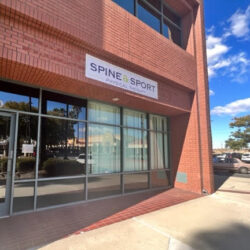The basics of shoulder pain
- Many things can cause shoulder pain, including actions such as throwing, racquet sports and heavy weight training, as well as less athletic activities like repetitive stresses, trauma and poor posture.
- It is important to seek medical advice from a doctor or physical therapist if mild shoulder pain does not subside or if it becomes more intense and starts to impact everyday life including work, home activities, exercise routines and/or sleep.
- Physical therapy is a great conservative option to treat shoulder injury, helping expedite recovery and often preventing the need for surgery or other more aggressive medical measures.
- Spine & Sport Physical Therapy offers a dedicated team of experts who aim to alleviate patients’ shoulder pain and get them moving forward, faster and fearlessly.
Move forward, faster, fearlessly
What is shoulder pain?
The shoulder is capable of incredibly complex movements and functions such as lifting, reaching, pulling and throwing. The shoulder can perform these complex movements, because it is more mobile than other joints of the body – thanks to a loose joint capsule, loose ligaments and muscles forming the rotator cuff. These muscles work to rotate the shoulder internally and externally and also work to keep the shoulder in the middle of the socket during overhead motions and other positions like putting the hand behind the back.
When the muscles, tendons, labrum or joint capsule get injured, the shoulder will become inflamed and painful. Typically, the shoulder will lose range of motion and become very stiff. This can make it difficult to move the arm and perform daily activities.
Our shoulders are involved in nearly every daily activity. Injuries can be very detrimental to our activity level, our work life and even our ability to sleep. Maintaining good mobility and strength in the shoulders and postural muscles is paramount to preventing injuries at all ages and activity levels.
Who can help with shoulder pain relief?
Milder injuries are usually go away on their own or with rest. But if pain persists, physical therapy, pain management or other interventions provided by a physician are necessary for relief.
Doctors who see patients with shoulder problems often refer individuals to a physical therapist for pain relief. However, patients can come to Spine & Sport Physical Therapy without a doctor’s referral – this is called direct access. After a thorough evaluation, our specialists can refer the patient to a doctor if imaging or more extensive evaluation is necessary or begin a physical therapy treatment plan.
Causes of shoulder pain
There are many reasons that the shoulder can be injured and cause pain including rotator cuff tears, labrum tears, tendonitis and fractures. These injuries can be immensely painful and limiting to everyday function.
One of the most common injuries is when the rotator cuff tendons become pinched under the acromion bone on the top of the shoulder. This causes the tendons to become damaged or inflamed, resulting in pain. This is called rotator cuff tendonitis or impingement syndrome.
Other factors contributing to an increased incidence of injury and pain are trauma, sports activities such as throwing or lifting, repetitive stresses, and even poor sitting and standing postures that lead to an increased incidence of shoulder injury.
Age can also contribute to an increased incidence of shoulder injury and pain, especially after the age of 60. This is because the internal structures and soft tissues surrounding the shoulder begin to degenerate over time.
Other common causes of shoulder pain include:
- Bursitis.
- Biceps tendonitis or tears.
- Frozen shoulder or adhesive capsulitis, which are stiffness of the shoulder capsule and ligaments in the shoulder.
- Rheumatoid arthritis or osteoarthritis.
- Bone spurs.
Sports injuries:
- Shoulder dislocation or acromio-clavicular separation.
- Overuse or strained muscles.
- Little leaguers arm.
- Growth plate injuries.
Surgical interventions:
- Rotator cuff repair or labral repair.
- Sub-acromial decompression.
- Total shoulder arthroplasty and reverse total shoulder arthroplasty.
- Platelet-rich plasma (PRP) and stem cell injections.
Other related injuries:
- Fractures of humerus, scapula or clavicle.
- Heart attack.
- Pinched nerves.
- Herniated discs.
Symptoms that require medical attention
Since a variety of conditions and issues can lead to shoulder pain, knowing the symptoms and getting a proper diagnosis are key to recovery.
Everyone’s pain tolerance is different. If pain is acute and intense or if milder pain becomes worse or prolonged and starts to impact daily activities, it’s time to see a specialist. Other symptoms of concern include:
- Pinching pain or weakness with lifting or reaching.
- Inability to lie on that side causing loss of sleep.
- Upper extremity weakness, grip weakness, tingling and burning sensation. However, this condition is more likely associated with the nerves of the neck.
- Clunking sound or painful click in outer ranges.
Diagnosing pain
The physical therapist or physician will listen to an individual’s reports of pain and perform a thorough evaluation to determine the origin of pain. This exam should test for any structural problems and rule out conditions involving the spine or neck.
A physician may also order imaging tests (X-rays, MRI or CT scan) to gain a closer look at the internal structures and external soft tissues of the shoulder. This can rule out or confirm an injury and its severity.
Risks of not treating shoulder pain
Shoulder pain should not be ignored. Milder injuries are usually temporary, but more complex injuries tend to linger and if left untreated can lead to surgery or other lasting consequences. Not seeking treatment can allow a smaller issue to become a more serious injury. An acute condition left untreated can become worse and worse, possibly becoming permanent.
Physical therapy is a great conservative care option and often times resolves the issue before it becomes more serious and requires surgery or more aggressive interventions.
Physical therapy treatments for shoulder pain
During the initial appointment, a physical therapist will perform a thorough evaluation of the shoulder and any surrounding regions that may be contributing to injury (cervical spine, throracic spine, shoulder blade). This exam will include tests of range of motion, joint stiffness, palpation of shoulder structures for pain, strength, coordination and resting postures.
After the exam, the therapist will develop a plan of care for the specific injury. Our therapists will educate individuals about their injury, the root causes and how we will work together to fix the problem and prevent its recurrence.
Once the plan is set, physical therapy treatments will begin. Depending on the specific injury, the treatment program may involve a combination of manual therapies, therapeutic exercises to load the injured structures and strengthen the surrounding muscles, and if needed, modalities (ice, heat, ultrasound, electrical stimulation) for inflammation control or pain reduction.
The therapist will also give the patient at-home exercises as an important part of the physical therapy plan. For the fastest and most complete rehabilitation, exercises must be done outside the PT appointment.
The physician may also prescribe medications to help reduce the inflammation and pain. These medications may include nonsteroidal anti-inflammatory drugs (NSAIDs) or corticosteroids (more aggressive prescription anti-inflammatory drugs taken by mouth or injected into the shoulder).
Throughout the treatment progression, the physical therapist will constantly test and re-test the structures for mobility, pain and strength. This will help guide the treatment plan for optimal recovery and pain relief. This is critical to ensure progress and avoid re-injury.
Spine & Sport physical therapists are also available to answer any questions or address any concerns a patient may have, whether it’s about the injury, recovery or how to modify everyday activities.
Overall, physical therapy is one of the best solutions to get relief of shoulder pain.
Learn more about physical therapy exercises
When to see a doctor for shoulder pain treatment and relief
If an injury has caused severe shoulder pain, the person should see a doctor first. Dislocation of the shoulder or major trauma such as a motor vehicle accident or a fall leading to a suspected fracture of the shoulder are good reasons to see a doctor immediately. Sometimes an emergency room visit is appropriate. Advanced imaging or medical intervention may be needed to stabilize these injuries.
If shoulder pain is sudden and not related to an injury, call 911. It could be a sign of a heart attack.
Treating pain in the shoulder can vary greatly depending on the underlying cause. Often times, the physicians will work in conjunction with the physical therapist to create an individualized treatment plan specific to the patient’s needs.
Get informed
- Occupational Therapy
- Orthopedic Chronic Pain &
Other Chronic Health Conditions - Pain Management With Physical
Therapy - Physical Therapy Services
Spine & Sport clinics offering physical therapy near me
All of our clinics in Southern & Northern California offer physical therapy services for shoulder pain.
 South San Diego County
South San Diego County Central San Diego County
Central San Diego County East San Diego County
East San Diego County North San Diego County
North San Diego County Orange County
Orange County Imperial County
Imperial County Coachella Valley
Coachella Valley Riverside County
Riverside County Ventura County
Ventura County Los Angeles County
Los Angeles County Northern California
Northern California